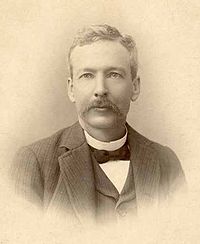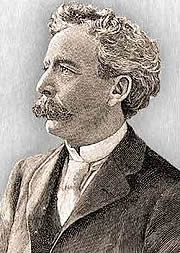Luther Burbank
He developed more than 800 strains and varieties of plants over his 55-year career. Burbank's varied creations included fruits, flowers, grains, grasses, and vegetables. He developed a spineless cactus (useful for cattle-feed) and the plumcot. Burbank's most successful strains and varieties include the Shasta daisy, the Fire poppy, the July Elberta peach, the Santa Rosa plum, the Flaming Gold nectarine, the Wickson plum, the Freestone peach, and the Burbank potato. Burbank also bred the white blackberry. A natural sport (genetic variant) of the Burbank potato with russet (reddish-brown) skin later became known as the Russet Burbank potato: this large, brown-skinned, white-fleshed potato has become the world's predominant processing potato. Life and workBorn in Lancaster, Massachusetts, Burbank grew up on a farm and received only an elementary education. The thirteenth of 15 children, he enjoyed the plants in his mother's large garden. His father died when he was 21 years old, and Burbank used his small inheritance to buy a 17 acre (69,000 m²) plot of land near Lunenburg.Burbank developed the Burbank potato, 1872 to 1874. Burbank sold the rights to the Burbank potato for $150 and used the money to travel to Santa Rosa, California, in 1875. Later, a natural sport of Burbank potato with russetted skin was selected and named Russet Burbank potato. Today, the Russet Burbank potato is the most widely cultivated potato in the United States, prized for processing. McDonald's french fries are made exclusively from this cultivar. In Santa Rosa, Burbank purchased a 4-acre (16,000 m2) plot of land, and established a greenhouse, nursery, and experimental fields that he used to conduct crossbreeding experiments on plants, inspired by Charles Darwin's The Variation of Animals and Plants under Domestication. (This site is now open to the public as a city park, Luther Burbank Home and Gardens.) Later he purchased an 18-acre (73,000 m2) plot of land in the nearby town of Sebastopol for more experimental growing called Gold Ridge Farm. Burbank was criticized by scientists of his day because he did not keep the kind of careful records that are the norm in scientific research and because he was mainly interested in getting results rather than in basic research. Jules Janick, Ph.D., Professor of Horticulture and Landscape Architecture, Purdue University, writing in the World Book Encyclopedia, 2004 edition, says: "Burbank cannot be considered a scientist in the academic sense." In 1893, Burbank published a descriptive catalog of some of his best varieties, entitled New Creations in Fruits and Flowers. In 1907, Burbank published an “essay on childrearing,” called The Training of the Human Plant. In it, he advocated improved treatment of children and eugenic practices such as keeping the unfit and first cousins from marrying. During his career, Burbank wrote, or co-wrote, several books on his methods and results, including his eight-volume How Plants Are Trained to Work for Man (1921), Harvest of the Years (with Wilbur Hall, 1927), Partner of Nature (1939), and the 12-volume Luther Burbank: His Methods and Discoveries and Their Practical Application. By all accounts, Burbank was a kindly man who wanted to help other people. He was very interested in education and gave money to the local schools. He married twice: to Helen Coleman in 1890, which ended in divorce in 1896; and to Elizabeth Waters in 1916. He had no children. Burbank also had a mystical, spiritual side. His friend and admirer Paramahansa Yogananda wrote in his Autobiography of a Yogi: "His heart was fathomlessly deep, long acquainted with humility, patience, sacrifice. His little home amid the roses was austerely simple; he knew the worthlessness of luxury, the joy of few possessions. The modesty with which he wore his scientific fame repeatedly reminded me of the trees that bend low with the burden of ripening fruits; it is the barren tree that lifts its head high in an empty boast." (Yogananda, 1946, p. 352) In a speech given to the First Congregational Church of San Francisco in 1926, Burbank said: "I love humanity, which has been a constant delight to me during all my seventy-seven years of life; and I love flowers, trees, animals, and all the works of Nature as they pass before us in time and space. What a joy life is when you have made a close working partnership with Nature, helping her to produce for the benefit of mankind new forms, colors, and perfumes in flowers which were never known before; fruits in form, size, and flavor never before seen on this globe; and grains of enormously increased productiveness, whose fat kernels are filled with more and better nourishment, a veritable storehouse of perfect food--new food for all the world's untold millions for all time to come." DeathIn mid-March 1926, Burbank suffered a heart attack and became ill with gastrointestinal complications. He died on April 11, 1926, aged 77, and is buried near the greenhouse at the Luther Burbank Home and Gardens.His last words were: "I don't feel good." LegacyBurbank's work spurred the passing of the 1930 Plant Patent Act four years after his death. The legislation made it possible to patent new varieties of plants (excluding tuber-propagated plants). In supporting the legislation, Thomas Edison testified before Congress in support of the legislation and said that "This [bill] will, I feel sure, give us many Burbanks." The authorities issued Plant Patents #12, #13, #14, #15, #16, #18, #41, #65, #66, #235, #266, #267, #269, #290, #291, and #1041 to Burbank posthumously.In 1986, Burbank was inducted into the National Inventors Hall of Fame. The Luther Burbank Home and Gardens, in downtown Santa Rosa, are now designated as a National Historic Landmark. Luther Burbank's Gold Ridge Experiment Farm is listed in the National Register of Historic Places a few miles west of Santa Rosa in the town of Sebastopol, California. The home that Luther Burbank was born in, as well as his California garden office, were moved by Henry Ford to Dearborn, Michigan, and are part of Greenfield Village. The following are named after the horticulturist: - Luther Burbank Elementary School in Oakland, California. - Luther Burbank High School in Sacramento, California. - Luther Burbank High School in San Antonio, Texas. - Luther Burbank Middle School in Houston, Texas. - Luther Burbank Elementary School in Milwaukee, Wisconsin. - Luther Burbank Middle School in Burbank, California. - The Luther Burbank School District in San Jose, California. - Santa Rosa's Luther Burbank Rose Parade and Festival. - Luther Burbank Elementary School in Burbank, Illinois. - Luther Burbank Elementary School in Santa Rosa, California. - Luther Burbank Savings Bank, with headquarters in Santa Rosa, California. - Santa Rosa used to have a performing arts center named after Burbank, but Wells Fargo bought naming rights for $3.2 million in 2006 and renamed it. - The Lancaster Middle School in Lancaster, Massachusetts, was renamed to Luther Burbank Middle School in 2003. - A middle school in Highland Park, Los Angeles, California, named Burbank Middle School was also named after Burbank. - Luther Burbank Elementary School in Altadena, California. - In 1931 the Boys Parental School located on Mercer Island, Washington, changed its name to Luther Burbank School. The school continued to function until 1966. The land on which the school was built was bought by King County and converted into Luther Burbank Park. - Burbank Elementary School in Roxana, Illinois, was named after Burbank. It was built in 1936, and an addition was added in 1966. With declining enrollment, the school was closed in 1983 and sold to a local chiropractor. It was transferred to the village and demolished in December of 2008. - Luther Burbank Park in Mercer Island, Washington. The town of Burbank, California, does not take its name from Burbank, but from the Los Angeles dentist David Burbank. Plant species named after Luther BurbankChrysanthemum burbankii Makino (Asteraceae)Myrica × burbankii A.Chev. (Myricaceae) Solanum burbankii Bitter (Solanaceae) Further reading- Harvest of the Years, Luther Burbank, with Wilbur Hall - This is Luther Burbank's autobiography published posthumously after his death in 1926.- Kraft, K. Luther Burbank, the Wizard and the Man. New York : Meredith Press, 1967 - Yogananda, Paramahansa. Autobiography of a Yogi. Los Angeles : Self-Realization Fellowship, 1946 - Peter Dreyer: A Gardener Touched With Genius The Life of Luther Burbank, # L. Burbank Home & Gardens; New & expanded edition (January 1993), - Burbank, Luther. “The Training of the Human Plant.” Century Magazine, May 1907. - Pandora, Katherine. "Luther Burbank". American National Biography. Retrieved on 2006-11-16. - Burbank, Luther. The Canna and the Calla: and some interesting work with striking results. Paperback - Burt, Olive W. Luther Burbank, Boy Wizard. Biography published by Bobbs-Merrill in 1948 aimed at intermediate level students. |






